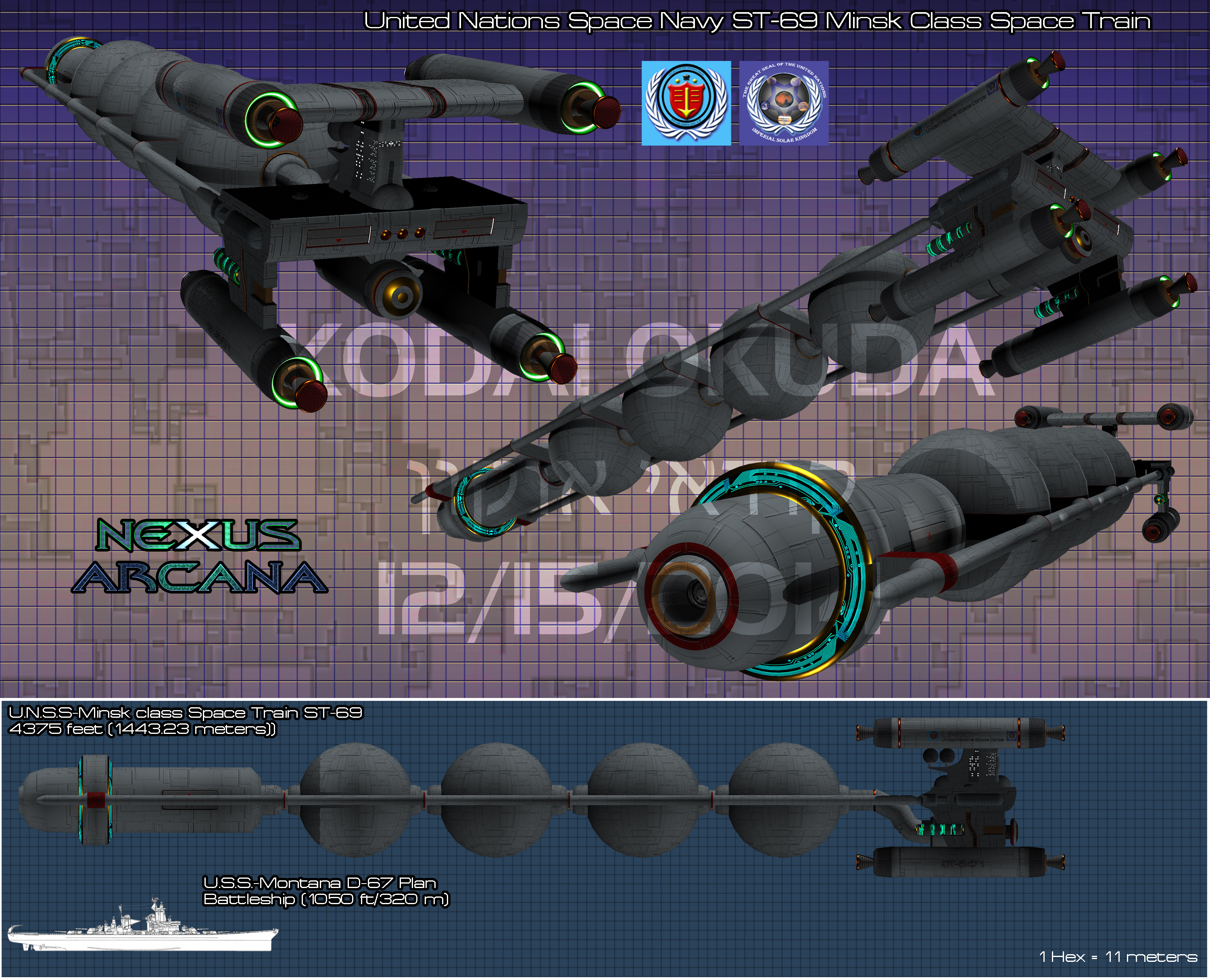SPECIFICATIONS

GOVERNMENT: United Nations Space Corps/Solar Empire
TYPE: Space Train Heavy Cargo Freighter
MODEL: Pallas Industrial PST-69
DATE INTRODUCED: 2169 AD
DIMENSIONS:
OVERALL: LENGTH: 4375 feet (1443.23 meters), WIDTH: 800 feet (243.84 meters), HEIGHT: 750 feet (228.6 meters)
Main ship: LG: 850 feet (259.08 meters), WD: 800 feet (243.84 meters), HT: 750 feet (228.6 meters)
Spherical Containers: DIAMETER: 500 feet (152.4 meters), HEIGHT: 500 feet (152.4 meters)
Cylindrical Containers: Length: 1000 feet (304.8 meters), DIAMETER: 250 feet (76.2 meters)
MATERIAL: Composite-Alloy
POWER PLANT: 206x Hensai Energy HEFR-4100 fusion reactor
OUTPUT: 4100 megawatts each reactor: 844,600 megawatts total
ARMOR TYPE: none
ARMOR THICKNESS: NA
DISPLACEMENT: 300,000 tons (650,000 tons with containers, 4)
CREW: 36 (4 Pilots, 4 Technicians, 4 Electricians, 4 Engineers, 2 Gunners, 2 Officers, 2 Medical, and 10 security)
PROPULSION
PRIMARY:
4x Daigun HYIE-162.5K
SPEED: 19,000 mph each (76,000 mph total)
WEAPONS:
PRIMARY (OFFENSIVE):
2x Cydonia Research CR-P100 dual PHELAC cannon turrets; Effective Range: 400 miles; Payload: unlimited with nuclear battery clutch system recharged by the shuttle's main reactor. ROF: 3 blasts every twenty seconds for up to 9 blasts per minute.
ELECTRONICS:
1x Microwave Communications array with a 10AU range.
1x Laser Communications array with a 1000 AU range.
1x RADAR array with a range of 200,000 miles.
1x Passive EMS array with a range of 1000 miles.
1x Active EMS array with a range of 1000 miles.
7x Antigravity control system. Description: 1 unit for each engine (provides Delta-V control and allows thrust both forward and aft), 1 unit for the main space train/tug for internal gravity and g-compensation, 1 unit for each of the two cargo rails that run along the sides of the cargo containers and provide the cargo containers with artificial gravity and g-force compensation.
DEFENSE SYSTEMS:
4xCydonia Research CR-DF-2000 omnidirectional LEVEL-1 Gravitonic deflector field generator; Range: 2000 feet from hull; Power Requirement: 2000 megawatts each; Output: 360 terajoules with a regeneration of 36 terajoules every ten seconds.
CARGO BAY:
1x 1368 cubic yards. A 10 year food and supplies were stored in this cargo bay.
4x 2660,000 cubic yard cargo containers carried outside the ship along the two cargo rails. Each of these cargo containers are capable of holding up to 260,000 cubic yards of a wide variety of cargo types; including tanks, battle robots, or other cargo and come in two types. The spherical type is used for hauling liquids and gasses, while the cylindrical type can haul solids, minerals, ore, or products.
HANGAR BAYS:
2x 20,000 yd3 hangars that can hold a wide variety of ships (usually three AS-01 type shuttles and up to 12 SF-01 or SF-01A space fighters).
Description/Overview:
After the end of the Great War, the UNSC came under the jurisdiction of the newly formed Solar Empire. The Atlas class of ships that once dominated the space lanes of the UNSC/Solar Empire corridors had been replaced by large numbers of the comparatively minute cargo shuttles that had been intended to replace them. The mighty Atlas class ships had been retired and converted into orbital spacestations after their duties as planetoid tugs had been completed. This left open a need for a craft capable of moving the much-needed gases from Venus to Mars as part of the UN terraforming projects for both worlds. The Solar Empire designers had initially considered the ST-68 as an adequate replacement for the Atlas, but quickly changed their minds as the USSN began fielding Juno class space frigates. Engineers on Pallas considered the possibility of building a train-like spacecraft that could ferry modules and carry a full two squadrons of assault shuttles to defend it from USSN warships and thus the PST-69 space train was borne.
The Minsk class, as it was dubbed by the Solar Empire, was the first twenty-five thousand-ton ship built by the UNSC and the largest spacecraft constructed by their shipyards since the Atlas. The Minsk was intended to pull up to five ten-thousand ton spherical cargo modules behind it via a “train car” type connection system and/or up to 5 five thousand-ton cylindrical cargo modules. The typical module configuration was four spherical containers and one cylindrical.

